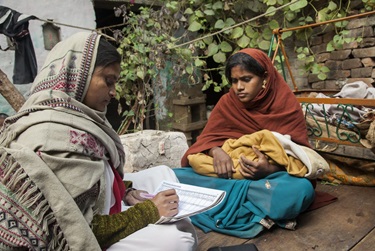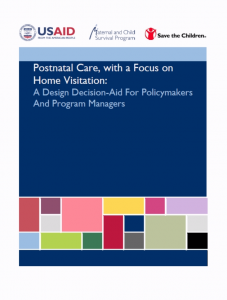
Current maternal–newborn program efforts direct considerable attention to the critical period around the time of birth. While this is an appropriate focus, the days and weeks that follow birth are also vitally important. Good care practices, timely medical care, and other services that address a variety of health issues also improve the likelihood of survival and better health and development outcomes.
Home visitation has been proposed as a way to achieve better outcomes during the postnatal period. While successful programs have been implemented in middle- and high-income countries for many decades, the current global effort to increase use of postnatal home visitation originated in a demonstration project in rural India in the 1990s. Several follow-up cluster randomized control trials tested variations on this model. The published trials found that under certain conditions such approaches can reduce the risk of newborn death. On the strength of these findings, WHO and UNICEF issued a joint statement in 2009 endorsing this approach.
While there is reason to anticipate considerable benefit from conscientiously delivered postnatal home visitation, what is feasible and what constitutes an optimal strategy will vary enormously by setting. Those responsible for such programs and services have a duty to ensure that the needs of the populations they serve are well met, working with the real-world opportunities and constraints they face. As much as we may prefer otherwise, there are no off-the-shelf strategies that fully address these needs in all settings.

Save the Children’s Saving Newborn Lives program and USAID’s Maternal and Child Survival Program have published a guidance document, Postnatal Care, with a Focus on Home Visitation, (developed with inputs from colleagues at WHO, UNICEF and USAID). This document offers some initial considerations for ministries of heath, national policymakers, and program managers to take into account as they design appropriate, strategic mixes of service delivery components to improve outcomes during the postnatal period and beyond. These considerations are intended to help them tailor their strategies to the needs and conditions particular to their setting, so that they may achieve the greatest impact that is feasible.
The overarching conclusion is that a country considering what may be the most appropriate strategies to improve postnatal outcomes should give serious attention to both feasibility and context.
We encourage countries to view programming holistically and to seek methods and tools that allow them to develop a flexible, tailored approach as they consider the incorporation of home visitation or other strategies into their health services.
Download Postnatal Care, with a Focus on Home Visitation >>

Blog by Stephen Hodgins, MD
Senior technical advisor, Saving Newborn Lives, Save the Children